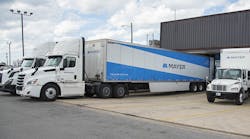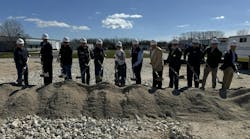The work began while Hurricane Katrina was still just a swirling, churning menace out in the Gulf of Mexico. She had hit Florida near Miami on Aug. 25 as a relatively mild Category 1 hurricane, causing little damage in a storm-seasoned region. Since crossing into the warmer waters of the Gulf, however, she had grown into a Category 5 monster packing sustained winds of 175 mph. It was clear she would hit the Gulf Coast in a few days. Area electric utilities and their suppliers swung into full disaster-preparation mode.
Distributors serving electric utilities along the Gulf Coast met with their clients in conference calls and face-to-face planning sessions to run through scenarios. Where was Katrina most likely to come ashore? What areas were most vulnerable to damage? How much material did the utilities have in their storm stocks, the cache of inventory that would get them through the first day or two after the storm hit? What did they need more of? Where could supplies and personnel be staged out of the storm's path but close enough to get to the affected area quickly once Katrina passed through?
Preparing for and responding to natural disasters is a central and inevitable part of being a utility distributor, especially along the Atlantic and Gulf Coasts where hurricanes like to visit in late summer. “This company has been in business for 50 years, and we've seen a lot of hurricanes,” says Wade Patterson, president of Tri-State Utility Products, Marietta, Ga. “When you've been through it so many times, you know you have to have a plan in place before the storm ever comes.”
When you have locations throughout the United States, like Orlando, Fla.-based Hughes Supply does, responding to disasters becomes a way of life year-round. “Twelve months out of the year, we have the potential for a natural disaster. We're always in some sort of storm mode,” says Joe LeNoir, southeast regional vice president of the company's utility division.
As seasoned as utility distributors may be, nothing could prepare them for the widespread devastation Katrina would bring to Louisiana, Mississippi and Alabama four days later.
As the storm blew nearer, taking aim at the coastline between New Orleans and Pensacola, Fla., the pace of preparations stepped up. Distributors were in constant communication with their primary manufacturers, getting updated information on inventory and availability, letting the manufacturers know what the situation was like on the ground, and making sure they had emergency contact information for night-time and weekend communications.
The distributors began bringing in people, inventory and equipment from other branches and staging them just outside the expected path of the storm. Stuart C. Irby Co., Jackson, Miss., moved 60 people from other branches into its facilities in Jackson, La.; Baton Rouge, La.; and Little Rock, Ark., the branches that would supply product into the storm-affected area.
They brought in tractor-trailers, delivery trucks, forklifts, generators for emergency backup power and several truckloads of pole-line hardware, automatic splices and all the other material that would be necessary for their customers to repair a damaged power grid.
Sales reps from Hughes Supply set up temporary offices in their customers' facilities to coordinate supply lines. Hughes equipped them with radiotelephones so that even if the phone systems were knocked out they could communicate with Hughes' nearest branch locations.
Hughes also arranged with its core freight carriers to have additional trucks, trailers and drivers on hand, stationed indefinitely at the company's facilities in Pensacola, Fla.
WESCO Distribution, Pittsburgh, which primarily serves Entergy and Cleco Corp. in the area, prepared its utility branches in Hammond, La., and Lafayette, La., picking and packing pre-storm orders throughout the weekend. Three employees agreed to stay in the Hammond facility and ride out the storm to be ready to take care of Entergy as soon as the danger had passed.
Priester Supply sent people and supplies from its headquarters in Arlington, Texas, to its branch in Hammond, La.
Tri-State Utility Products bulked up its inventory and personnel in Birmingham, Ala.; Tallahassee, Fla.; and Atlanta.
Preparations continued into the last hours, as wind and rain at the front of the storm began to be felt on land. “Preparation picks up in intensity as we find out more about where the storm's going to come in,” says Rick McClure, vice president of utility operations for Hughes Supply. “We had our last conference call with our customers at 8 p.m. on Sunday, just hours before Katrina hit.”
In the early hours of Monday, Aug. 29, Hurricane Katrina rolled in with a fury. She was downgraded to Category 4 just before making landfall but still packed winds of more than 140 mph and poised to pound communities from New Orleans to Pensacola as she came off the water. Even for utility distributors accustomed to responding to hurricanes, Katrina was unusual in many ways. Above all was her sheer power. She wiped out whole towns along the coast overnight.
Her impact on New Orleans caught the nation's attention, due mostly to the flooding that began a day later when the levees protecting it from the Mississippi River and Lake Pontchartrain gave way, inundating one of the nation's most distinctive cities and leading to a massive and troubled evacuation of millions of people.
For the first couple of weeks, it was impossible to even begin rebuilding the electrical infrastructure in New Orleans. Officials declared a state of emergency and concentrated on life-saving measures, fixing the levees and draining the city. Once the rebuilding began, supply lines into New Orleans were handled by the local utilities, primarily Entergy. Distributors delivered their supplies to Entergy's marshalling yard at its headquarters in Hammond, La., northwest of New Orleans across Lake Pontchartrain.
But scenes of utter devastation stretched far beyond New Orleans. Throughout coastal Mississippi and Alabama, for miles and miles along every roadway, ditches and culverts were packed with refrigerators, cars, farm implements, and pieces of houses. Trees hung thick with clothing from miles away, washed in on the storm surge. Fallen trees, debris and power lines blocked nearly every road. Birds vanished. The Gulf Coast seemed a wet wasteland.
The first priority for all the distributors immediately after the storm passed was to contact all their employees to make sure they were safe, and to make arrangements for getting them back to work.
Priester Supply's location in Hammond sustained limited damage, but it lost all power and communication services. “After Katrina hit, our problem here in the home office was finding our employees. There were no communications — no land lines, no e-mail. It was hard to get through on cell phones because the system was jammed. To hear from everybody took two days. Some employees had to evacuate their homes. Some went as far north as Arkansas,” says Steve Hawrylak, operations manager.
The next order of business for Priester was to find a new base of operations for its Hammond facility. Thanks to a close working relationship with Dis-Tran, a manufacturer of wood cross-arms and distribution timbers for utility poles, Priester was able to set up a makeshift supply house in a temporary storage trailer at the back of a lot at Dis-Tran's general offices in Pineville, La.
Irby's Mobile, Ala., branch suffered significant water damage; its Pascagoula, Miss., branch suffered damage from both water and wind; and its locations in Hattiesburg and McComb, Miss., suffered wind damage, as well as the widespread loss of power.
Restoring communications — both phone lines and computer connections — was critical. Irby had distributed satellite phones to its branches, but its service provider had been knocked out, so the company ended up switching providers twice in the week after the storm, says Eddie Moak, vice president of utility operations for Irby.
There was a lull after the storm as distributors waited for utilities to assess the extent and nature of the damage. Once the reports and requests for materials began to roll in, distributors jumped into action. Despite all their experience and all their preparations, distributors' response to Katrina's devastation became an exercise in thinking on their feet at a dead run.
From the time the storm hit, through the following two weeks, distributors' personnel logged 18-hour and 20-hour days, seven days a week. They worked through Labor Day weekend without complaint. The intensity of the work was both a valuable distraction from thoughts of the human impact of the disaster and a chance to contribute in a substantial way to recovery. People's moods were upbeat for the first week, at least, distributors say. The adrenaline rush, the sense of purpose, and the sheer magnitude of the work to be done kept them going. After a week or more of nonstop extra effort, signs of strain and exhaustion began to show, but they kept pushing.
WESCO cycled management, warehouse people and truck drivers from other locations in three-day shifts to keep the fatigue at bay, says Don Thimjon, vice president of the company's utility operations.
Obtaining product was a constant challenge. “The first guy to the water fountain gets to take a drink, and after that things start to get squirrelly,” is how Patterson of Tri-State put it. One of his manufacturers told him the volume of product they shipped for the Katrina recovery was greater than for all four major hurricanes that hit the United States in 2004.
Distributors worked the phones and online inventory systems mercilessly, searching every possible source for the products their customers needed. Availability changed from minute to minute. “We could be on a phone call one minute and they had the stock we needed, and we'd call back a minute later and it would be gone,” says Moak. “Any info we got was only good for a short period of time.”
Through membership in the North American Association of Utility Distributors (NAAUD), Lady Lake, Fla., most distributors had access to an emergency notification service that allows members to issue requests for supplies to utility distributor contacts throughout the United States and Canada. The system was valuable, but there aren't many distributors that carry large inventories of excess material. Most of the supplies had to come direct from the manufacturers, says Moak.
The hardest to get, said distributors, were wooden cross-arms and poles. There were also shortages in automatic splices, H-frame connectors, pole-line hardware and other common transmission and distribution supplies. Distributors reported that products normally available in two to three weeks were now reporting lead times of two to three months. Manufacturers were working flat out, running their production lines around the clock, and still were falling far behind demand.
Logistics turned out to be a major issue for everyone in responding to the disaster. Arranging with freight carriers to station trucks and trailers in Pensacola turned out to be a very good move, says LeNoir of Hughes Supply. “One thing FEMA did a good job on was confiscating as many tractors, trailers, buses and campers as they could. If you didn't already have precommitted resources, you would be in trouble.”
Some of the manufacturers had material available to ship but no fleet to pick it up. Hughes Supply took matters into its own hands and sent trucks across the country to bring supplies back. “We would say, ‘Tell me within two hours when it's going to be staged and ready to ship, and we'll have a truck there. And because we had the resources, we were able to take the material direct to the customer, rather than going through the typical transfer terminals,” says LeNoir.
Hiring contract drivers created some problems for WESCO. The company moved its own drivers into the warehouse, where their familiarity with the products and company policies made them more valuable. But the hired drivers turned out to be less than reliable, sometimes walking off the job or failing to show up at all, says Thimjon.
Getting trucks into the storm-ravaged area was another matter entirely. Utilities set up staging areas in shopping center parking lots, convention center parking lots and church parking lots — anyplace where there was enough space to work.
With much of the area under a state of emergency, it was necessary in some cases to secure a police escort to get to the staging area. Hughes Supply gave all its drivers documentation to carry with them, to confirm for authorities who they were.
Adding to the logistical problems, fuel availability became an unexpected and major concern. “Who would think you'd run out of fuel?” says Moak of Irby. Power to several pipeline pumping stations had been knocked out by the storm, and service stations were running out of gasoline and diesel fuel. Irby and Hughes both leased fuel tanks to ensure a supply of fuel for their trucks and equipment.
A driver carrying a shipment from a Tri-State Utility Products location in Tallahassee, Fla., into Mississippi ran out of fuel along the way, says Patterson. Through the company's connections with one of its customers, Southern Co., it was able to contact Gulf Power, a sister company, which sent a fuel truck to get the rig back underway.
Another unusual aspect of dealing with Katrina's aftermath was the environmental conditions, primarily due to the flooding. “We had all employees with any association to working this storm, including contract drivers, taking tetanus and hepatitis shots,” says LeNoir of Hughes Supply. “We had never had to do that before.”
Disruptions in supply of some products, especially utility poles and wooden cross-arms, automatic splices and pole-line hardware, are expected to continue for a month or so as manufacturers work to restore inventories. Many utilities and distributors outside the storm-ravaged area contributed materials from their inventory to the recovery effort, and they will have to be replenished.
“With the exception of customers we had to rob material from, we're getting back to normal,” Patterson of Tri-State Utility Products said in late September. “You can borrow from Peter to pay Paul, but eventually Peter gets angry and says, ‘What about me?’ We're through the few weeks of total chaos, but we're still looking at 30 to 45 days of semi-chaos in the supply chain.”
By Sept. 22, distributors were beginning to see the light at the end, and it's not just a figure of speech. “We can usually tell they're close to being done rebuilding what can be rebuilt when they start ordering lights,” says McClure of Hughes Supply. “They'll do the transmission systems first, then the substations, the distribution lines, the feeders, then the individual end-user services, and lighting comes last. Just in the last day or so, we've started getting orders for street lighting from Alabama and Mississippi.”
Just as the pace was beginning to slow down, and exhausted distributors returned to a more normal, 10-hour day, there came word that another storm named Rita, as if she were a little sister following Katrina's footsteps, crashed across the Florida Keys and into the Gulf, where she began building strength, again reaching Category 5 status and taking aim at Louisiana and South Texas. With no time to catch their breath, utility distributors shifted into preparation mode once again, this time facing the added challenge of a supply chain drained dry.
“There's no way you can get ready for a Cat-5. It just can't be done,” says Patterson of Tri-State Utility Products. “You just take it a day at a time and do the best you can do.”








